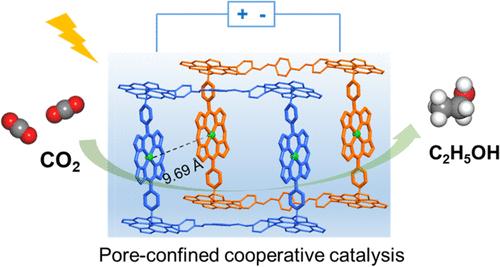单晶金属有机和共价有机框架杂化物实现了高效的光电化学CO2还原为乙醇
IF 15.6
1区 化学
Q1 CHEMISTRY, MULTIDISCIPLINARY
引用次数: 0
摘要
通过光化学和电化学CO2还原反应(CO2RR)生产的多碳醇是有希望的化石燃料替代品;然而,由于碳-碳偶联的高能量垒和来自油气生产的竞争,它们的选择性和效率仍然很低。在这里,我们提出了一种策略,以提高乙醇效率和选择性,通过协同催化在多孔结构的光电化学(PEC) CO2RR。采用配位模板策略,合成了金属卟啉与MOF-COF (moof)杂化物的单晶,并通过单晶三维电子衍射对其结构进行了表征。多孔框架具有相邻的受限金属卟啉有效捕获和协同激活二氧化碳,实现出色的PEC二氧化碳到乙醇的转化。特别是,pt - moof在- 1.0 V下的法拉第效率(FE)为83.5%,碳选择性为91.7%,超过了目前最先进的COF或MOF催化剂,成为性能最好的催化剂之一。该催化剂体系表现出显著的稳定性,连续运行100 h后仍能保持95%的活性。实验和理论计算表明,协同催化剂丰富和稳定了通道中的中间体,引导了反应途径向乙醇生产的转变。本文章由计算机程序翻译,如有差异,请以英文原文为准。

Single-Crystal Metal–Organic and Covalent Organic Framework Hybrids Enable Efficient Photoelectrochemical CO2 Reduction to Ethanol
Multicarbon alcohols produced through photochemical and electrochemical CO2 reduction reactions (CO2RR) are promising alternatives to fossil fuels; however, their selectivity and efficiency remain low due to the high energy barrier for C–C coupling and the competition from hydrocarbon production. Here, we present a strategy to enhance ethanol efficiency and selectivity via cooperative catalysis in porous structures for photoelectrochemical (PEC) CO2RR. Using a coordination-templated strategy, we synthesized single crystals of MOF-COF (MOCOF) hybrids with metalloporphyrins, with their structures determined by single-crystal 3D electron diffraction. The porous frameworks featuring adjacent confined metalloporphyrins efficiently capture and cooperatively activate CO2, achieving outstanding PEC CO2-to-ethanol conversion. Particularly, the Pt-MOCOF delivers a Faradaic efficiency (FE) of 83.5% at −1.0 V with 91.7% carbon selectivity, surpassing state-of-the-art COF or MOF catalysts and ranking it among the top-performing catalysts. The catalyst system displays remarkable stability, maintaining 95% of its activity after 100 h of continuous operation. Experiments and theoretical calculations revealed that the cooperative catalyst enriches and stabilizes intermediates in the channels, guiding the reaction pathway toward ethanol production.
求助全文
通过发布文献求助,成功后即可免费获取论文全文。
去求助
来源期刊
CiteScore
24.40
自引率
6.00%
发文量
2398
审稿时长
1.6 months
期刊介绍:
The flagship journal of the American Chemical Society, known as the Journal of the American Chemical Society (JACS), has been a prestigious publication since its establishment in 1879. It holds a preeminent position in the field of chemistry and related interdisciplinary sciences. JACS is committed to disseminating cutting-edge research papers, covering a wide range of topics, and encompasses approximately 19,000 pages of Articles, Communications, and Perspectives annually. With a weekly publication frequency, JACS plays a vital role in advancing the field of chemistry by providing essential research.

 求助内容:
求助内容: 应助结果提醒方式:
应助结果提醒方式:


